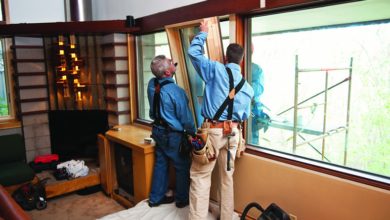Hidden Home Maintenance Issues You Must Address

Your home might look flawless, but hidden maintenance issues can quietly develop over time, costing thousands in repairs if ignored. Problems like water damage, electrical issues, or foundation cracks often show subtle signs before escalating. Regular inspections and early fixes can save money and prevent major headaches. Let’s explore what to watch for!
Roof Inspection: Detecting Leaks and Damage
Your roof works 24/7 to protect your home, making it one of the most critical systems to monitor. Unfortunately, roof problems often remain hidden until water starts dripping into your living space—by which point, damage may already be extensive.
Start your inspection from the inside. Visit your attic during daylight hours and look for any spots where sunlight penetrates through the roof. These pinpricks of light indicate potential leak points. Check for water stains on the underside of the roof decking, which appear as dark patches or discoloration. Even old stains deserve attention, as they may indicate areas where leaks could recur.
From the outside, examine your roof using binoculars if it’s too steep to access safely. Look for missing, cracked, or curled shingles. Pay special attention to areas around chimneys, vents, and skylights, where flashing can deteriorate over time. Granules accumulating in your gutters signal aging shingles that may need replacement soon.
Don’t overlook your gutters during roof inspections. Clogged or damaged gutters can cause water to back up under shingles, leading to rot in your roof’s wooden components. Clean gutters regularly and ensure they’re properly secured to your home’s fascia boards.
Door Inspection: Detect Damages
Doors endure constant use, weather exposure, and temperature fluctuations, making them susceptible to various forms of deterioration. Entry doors face the harshest conditions, while interior doors can develop problems from humidity changes and settling foundations.
Examine door frames for gaps, cracks, or signs of water damage. These issues can compromise your home’s energy efficiency and security. Run your hand around door frames to feel for air leaks, which indicate worn weatherstripping or warped frames. Check that doors close and latch properly—sticking or difficult-to-close doors may signal foundation settling or frame warping.
Garage doors demand careful maintenance due to their size and mechanical intricacy. Regularly inspect the tracks, springs, and cables for any signs of wear or damage. If your garage door starts operating unevenly, makes unusual noises, or shows signs of malfunction, it’s crucial to address these issues promptly. Residential garage door repair services, such as those available in Utah, can resolve these problems effectively. Keep in mind that garage door springs are under high tension and can be hazardous if they fail, potentially leading to serious injuries or property damage.
Look for rust on metal components, dry rot in wooden doors, and deterioration in weather seals. These problems worsen quickly when left untreated, especially in harsh weather conditions.
Plumbing Check: Identifying Hidden Leaks
Hidden plumbing leaks rank among the most destructive and expensive home maintenance issues. A small leak behind a wall can cause extensive damage to framing, insulation, and drywall before you notice any obvious signs.
Monitor your water bill for unexplained increases, which often indicate hidden leaks. Even a small leak can waste hundreds of gallons per month. Check your water meter when no water is being used in your home—if the meter continues to run, you likely leak somewhere in your system.
Inspect areas around plumbing fixtures for soft spots in floors or walls, which may indicate water damage. Pay attention to musty odors, particularly in bathrooms, basements, and areas near water heaters. These smells often accompany hidden moisture problems.
Don’t forget about your water heater, which typically lasts 8-12 years. Look for rust, corrosion, or small puddles around the base. Listen for unusual noises during operation, such as popping or rumbling sounds that may indicate sediment buildup or internal damage.
Check exposed pipes in basements, crawl spaces, and utility areas for corrosion, joints that appear loose, or any signs of moisture. Insulate pipes in unheated areas to prevent freezing, which can cause catastrophic failures during cold weather.
See also: 10 Legitimate Ways to Earn Money From Home
Electrical Systems: Inspecting Wiring and Outlets
Electrical problems pose serious safety risks, including fire hazards that can destroy your home and endanger your family. Many electrical issues develop gradually, making regular inspection essential for early detection.
Test all GFCI outlets monthly using the test and reset buttons. These safety devices protect against electrical shock in areas exposed to moisture, such as bathrooms, kitchens, and outdoor locations. If a GFCI outlet fails to trip when tested or won’t reset properly, replace it immediately.
Check your electrical panel for signs of problems. Look for rust, scorch marks, or a burning smell, which may indicate dangerous conditions. Circuit breakers that trip frequently signal overloaded circuits or potential wiring problems. Flickering lights, especially when large appliances turn on, can indicate loose connections or inadequate wiring.
Examine outlets and switches throughout your home. Plates that feel warm to the touch, outlets that spark when plugs are inserted, or switches that don’t operate smoothly all warrant professional attention. Old homes may have outdated wiring that can’t safely handle modern electrical demands.
Don’t attempt electrical repairs yourself unless you have proper training. Electrical work requires permits and professional expertise to ensure safety and code compliance.
HVAC Systems: Assessing Efficiency and Air Quality
Your heating, ventilation, and air conditioning system affects both your comfort and your energy bills. Hidden problems in HVAC systems often reduce efficiency gradually, increasing your utility costs while decreasing indoor air quality.
Replace air filters regularly—typically every 1-3 months depending on usage and filter type. Dirty filters force your system to work harder, increasing energy consumption and potentially damaging expensive components. Check filters monthly and replace them when they appear dirty or clogged.
Inspect ductwork in accessible areas for disconnected joints, holes, or damage. Leaky ducts can waste 20-30% of your heating and cooling energy. Look for dust accumulation around vents, which may indicate air leaks or filtration problems.
Listen to your HVAC system during operation. Unusual noises such as grinding, squealing, or banging can indicate mechanical problems that worsen over time. Pay attention to uneven heating or cooling throughout your home, which may signal ductwork issues or system imbalances.
Clean outdoor units regularly, removing debris, leaves, and vegetation that can obstruct airflow. Ensure at least two feet of clearance around outdoor units for proper operation. Schedule professional maintenance annually to catch problems early and maintain peak efficiency.
Foundation: Spotting Cracks and Water Intrusion
Your home’s foundation supports the entire structure, making foundation problems among the most serious maintenance issues you can face. Foundation damage develops slowly but can eventually threaten your home’s structural integrity.
Walk around your home’s exterior, examining the foundation for cracks, settling, or other signs of movement. Small hairline cracks may be normal settling, but larger cracks or cracks that grow over time require professional evaluation. Take photos of any cracks you find and monitor them for changes.
Inside your home, look for signs of foundation problems such as doors and windows that stick or won’t close properly, cracks in walls or ceilings, and floors that feel bouncy or uneven. These symptoms may indicate foundation settlement or structural movement.
Check your basement or crawl space regularly for water intrusion. Look for water stains, efflorescence (white, chalky deposits), or actual standing water. Moisture problems can lead to mold growth and structural damage if not addressed promptly.
Ensure proper drainage around your home’s foundation. Gutters should direct water away from the foundation, and the ground should slope away from your home. Poor drainage is a leading cause of foundation problems and water intrusion.
Conclusion
Stay proactive with hidden home maintenance by creating a seasonal checklist and documenting findings. Prioritize safety and costly issues like electrical or structural problems, and consult professionals when needed. Early repairs save money long-term, and many contractors offer maintenance plans. Keep detailed records of maintenance for tracking and future use. Prevention is key to protecting your investment and safety.





